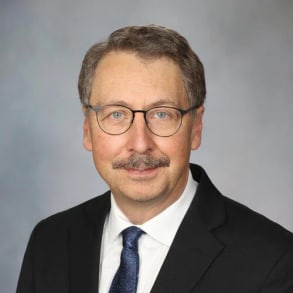Mayo Clinic's Eugene L. Scharf, M.D ., Robert D. Brown Jr., M.D., M.P.H. , Harry Cloft, M.D., Ph.D. , and Giuseppe Lanzino, M.D. , explain what to do when carotid stenosis is discovered and how Mayo Clinic can help with this diagnosis.
When carotid stenosis is discovered, it is important to seek treatment right away. Up to 20% of all strokes are caused by carotid artery disease.
At Mayo Clinic, a care team of doctors will work together to provide you a comprehensive diagnosis and care options. Each year, Mayo Clinic specialists treat approximately 6,000 patients with carotid artery disease.
To learn more about carotid artery with stenosis and receiving care at Mayo Clinic, visit our website .
Multiple strokes that would have happened even as recently as 20 years ago, have been now completely avoided. When we see plaque narrowing the opening of the artery we call that disease carotid stenosis. Carotid stenosis is a well known cause of stroke. Carotid is a main artery that runs up the front of the neck and in many cases this carotid artery can be laden with cholesterol plaque over the course of one's lifetime. When a carotid stenosis is discovered, it's critically important to stratify the risk of stroke. We have advanced carotid plaque imaging techniques that is honing in and looking at that plaque in detail. We can look at the actual wall of the blood vessel in certain circumstances in something called vessel wall imaging, which allows us to characterize the nature of the narrowing. Typically there are two routes to treatment with respect to carotid stenosis. On the one hand, there is a route of treatment called medical therapy. On the other side of the coin would be an interventional or revascularization procedure. The main change has been the advances in endovascular techniques and that's something that's come a long way in the last 30 years where new devices have been engineered that allow us to get to places that we in the past couldn't get to. It allows you to tailor as much as possible the treatment to the individual patient to the individual problem and be able to do it very, very safely. Most of the times. Many of our procedures that we do here with an endovascular approach. It's a radiologist and a neurosurgeon working together, we do our best to leverage the expertise of each without excluding anyone. We have fantastic nurses, allied health personnel, administrative colleagues. I think that's the beauty of Mayo Clinic, as we can bring various colleagues together in a very efficient way for the patient and bring these opinions together, focusing on their particular case and their particular needs.




